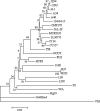Novel human rotavirus of genotype G5P[6] identified in a stool specimen from a Chinese girl with diarrhea
- PMID: 17301275
- PMCID: PMC1865876
- DOI: 10.1128/JCM.00032-07
Novel human rotavirus of genotype G5P[6] identified in a stool specimen from a Chinese girl with diarrhea
Abstract
During a rotavirus surveillance conducted in Lulong County, Hebei Province, China, a total of 331 stool specimens collected in 2003 from children under 5 years old with diarrhea were screened. We identified a novel group A human rotavirus of genotype G5P[6]. Phylogenetic analysis confirmed that the VP7 protein of this newly identified strain, LL36755, was closely related to those of the G5 strains. As such, it has 95.4% homology with its counterparts in the porcine G5 strains C134 and CC117 at the amino acid sequence level. On the other hand, the VP4 protein of the LL36755 strain was 94.5% homologous to those of the porcine P[6] strains 134/04-10, 134/04-11, 221/04-7, and 221/04-13. Our findings indicate a dynamic interaction between human and porcine rotaviruses.
Figures


Comment in
-
Possible misidentification of GSP[6] rotavirus as a novel strain detected in humans for the first time.J Clin Microbiol. 2007 Jun;45(6):2098; author reply 2099. doi: 10.1128/JCM.00555-07. J Clin Microbiol. 2007. PMID: 17548461 Free PMC article. No abstract available.
References
MeSH terms
Associated data
- Actions
- Actions
LinkOut - more resources
Full Text Sources
Medical
Research Materials

